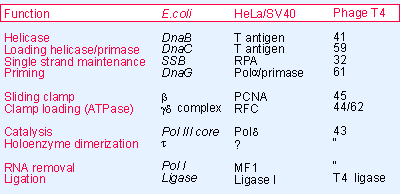11. The replication apparatus of phage T4
13.11 The replication apparatus of phage T4 |
When phage T4 takes over an E. coli cell, it provides several functions of its own that either replace or augment the host functions. The phage places little reliance on expression of host functions. The degradation of host DNA is important in releasing nucleotides that are reused in the synthesis of phage DNA. (The phage DNA differs in base composition from cellular DNA in using hydroxymethylcytosine instead of the customary cytosine.)
The phage-coded functions concerned with DNA synthesis in the infected cell can be identified by mutations that impede the production of mature phages. Essential phage functions are identified by conditional lethal mutations, which fall into three phenotypic classes:
- Those in which there is no DNA synthesis at all identify genes whose products either are components of the replication apparatus or are involved in the provision of precursors (especially the hydroxymethylcytosine).
- Those in which the onset of DNA synthesis is delayed are concerned with the initiation of replication.
- Those in which DNA synthesis starts but then is arrested include regulatory functions, the DNA ligase, and some of the enzymes concerned with host DNA degradation.
- There are also nonessential genes concerned with replication; for example, including those involved in glucosylating the hydroxymethylcytosine in the DNA.
Synthesis of T4 DNA is catalyzed by a multienzyme aggregate assembled from the products of a small group of essential genes.
The gene 32 protein (gp32) is a highly cooperative single-strand binding protein, needed in stoichiometric amounts. It was the first example of its type to be characterized. The geometry of the T4 replication fork may specifically require the phage-coded protein, since the E. coli SSB cannot substitute. The gp32 forms a complex with the T4 DNA polymerase; this interaction could be important in constructing the replication fork.
The T4 system uses an RNA priming event that is similar to that of its host. With single-stranded T4 DNA as template, the gene 41 and 61 products act together to synthesize short primers. Their behavior is analogous to that of DnaB and DnaG in E. coli. The gene 41 protein is the counterpart to DnaB. It is a helicase, and also has a GTPase activity stimulated by single-stranded DNA. When the protein binds to single-stranded DNA, it can move from its initial binding site, migrating at a rate of ~400 nucleotides per second. It probably functions like DnaB, finding periodic sites at which to initiate primer synthesis. The hydrolysis of GTP is presumed to provide the energy for movement. Binding of the helicase to DNA is stimulated by the gene 59 product.
The gene 61 protein is needed in much smaller amounts than most of the T4 replication proteins. There are as few as 10 copies of gp61 per cell. (This impeded its characterization. It is required in such small amounts that originally it was missed as a necessary component, because enough was present as a contaminant of the gp32 preparation!) Gene 61 protein has the primase activity, analogous to DnaG of E. coli. The primase recognizes the template sequence 3′ VTTG V5′ and synthesizes pentaribonucleotide primers that have the general sequence pppApCpNpNpNp. If the complete replication apparatus is present, these primers are extended into DNA chains.
The gene 43 DNA polymerase has the usual 5′ V3′ synthetic activity, associated with a 3′ V5′ exonuclease proofreading activity. It catalyzes DNA synthesis and removes the primers. When T4 DNA polymerase uses a single-stranded DNA as template, its rate of progress is uneven. The enzyme moves rapidly through single-stranded regions, but proceeds much more slowly through regions that have a base-paired intrastrand secondary structure. The accessory proteins assist the DNA polymerase in passing these roadblocks, and maintaining its speed.
The remaining three proteins are referred to as "polymerase accessory proteins." They increase the affinity of the DNA polymerase for the DNA, and also its processivity and speed. The gene 45 product is a dimer that probably acts as a "sliding clamp," equivalent to subunit β of E. coli DNA polymerase III, holding the DNA polymerase subunit more tightly on the template.
The products of genes 44 and 62 form a tight complex, which has ATPase activity. Their main role may be to link gp45 to gp43; they could be the equivalent of the γδ complex. As we have mentioned before, this type of intimate relationship makes it a moot point what is a component of DNA polymerase and what is an accessory factor.
We have dealt with DNA replication so far solely in terms of the progression of the replication fork. The need for other functions is shown by the DNA-delay and DNA-arrest mutants. The four genes of the DNA-delay mutants include 39, 52, and 60, which code for the three subunits of T4 topoisomerase II, an activity needed for removing supercoils in the template (see 14 Recombination and repair). The essential role of this enzyme suggests that T4 DNA does not remain in a linear form, but becomes topologically constrained during some stage of replication. The topoisomerase could be needed to allow rotation of DNA ahead of the replication fork.
 |
Figure 13.24 Similar functions are required at all replication forks. |
Comparison of the T4 apparatus with the E. coli apparatus suggests that DNA replication poses a set of problems that are solved in analogous ways in different systems. We may now compare the enzymatic and structural activities found at the replication fork in E. coli, T4, and HeLa (human) cells. Figure 13.24 summarizes the functions and assigns them to individual proteins. We can interpret the known properties of replication complex proteins in terms of similar functions, involving the unwinding, priming, catalytic, and sealing reactions. The components of each system interact in restricted ways, as shown by the fact that phage T4 requires its own helicase, primase, clamp, etc., and the bacterial proteins cannot substitute for their phage counterparts.